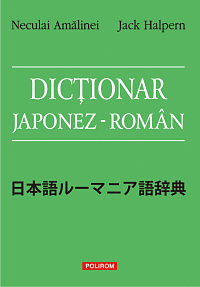 Japanese Language online course. Japanese Language online course.
For information please email us or complete the form in the contact page.
|
|
 |
| |
 Japanese-Romanian Dictionary Japanese-Romanian Dictionary
Authors: Neculai Amalinei, Jack Halpern
Polirom Publishing House, Iasi, 2013.
Cardboard Edition
916 pages, 130x200 mm
ISBN: 978-973-46-3237-2
Price: 99 RON
Available: Yes
:: Order online ::
|
 |
The Japanese-Romanian dictionary was designed to cover 22,000 entries including the most common meanings. They are presented in both romanized and standard Japanese writing. Many entries include subentries raising the total terms in the dictionary up to 31,000.
Due to the romanizing of the Japanese entries, users without a knowledge of Japanese writing can grasp the meaning of words.
The dictionary is compact and convenient to carry around, and it is a valuable tool for non-native speakers of Japanese: undergaduates, businessmen, travelers, a.s.o.
Acknowledgements
For developing the Japanese-Romanian dictionary, two objectives had to be completed:
- setting up a background for the Japanese language (which also included basic grammar structures);
- description and explanation of a certain number of kanji - the Chinese characters used in Japanese writing (without at least a working knowledge, the entries would have been difficult to understand).
In order to achieve this goal the following books: Japanese Language Simply and Efficiently and Japanese Language. Grammar Exercises and Vocabulary were written. The Japanese-Romanian Gakushū Kanji Dictionary, that covers the 1,006 kanji taught in the first six grades in the Japanese compulsory school, have been written.
I am grateful to the prestigious Polirom Publishing House for the publication of these works over ten years of collaboration (the Japanese Language Simply and Efficiently has reached now the sixth edition).
The lexicographic works mentioned above required extremely laborious work and also a particular logistics (particular fonts, stroke order diagrams for kanji, sanity checks, etc).
To write books and reference works, one has to work with specialists from the chosen field of activity.
Therefore, the Japanese-Romanian dictionary could not have been completed without the constant and generous support offered by Prof. Dr. James Breen from Monash University, Australia.
Not only the kind attention (I received advice and solutions each time I failed) and the technical guidance (I was offered access to the KANJIDICT and EDICT electronic dictionnaries), but also his sensitivity and profoundness were engraved into my conscience.
I express my gratitude for everything he has done for me during the 15 years of our collaboration and friendship.
Someday, when the text editors I used did not match the encoding methods required by kanji, Dr. Breen introduced me to Ken Lunde, a genuine artist and magician in the world of Japanese fonts.
Dr. Ken Lunde is Senior Computer Scientist and an outstanding professional CJKV Font Maker at Adobe Systems Incorporated.
In 2008, O'Reilly Publishing House published the second edition of Dr. Ken Lunde’s book entitled CJKV Information Processing, considered to be "the bible of Asian language information processing".
Ken kindly answered all my questions related to character set standards, encoding methods, input methods, rules used in typography for writing in Japanese a.s.o.
Dr. Ken Lunde helped me with the particular fonts required to write the Japanese texts that I just mentioned. I would like to express my gratitude for his assistance, since without these fonts the above mentioned books could not have been written. Besides being a genuine professional, Ken is a dear friend.
When we discussed about the possibility of publishing Japanese dictionaries in Romania, Dr. Ken Lunde recommended Mr. Jack Halpern, CEO & President, CJK Dictionary Institute, in Tokyo. He is Editor-in-Chief of the New Japanese-English Character Dictionary and Kanji Learner’s Dictionary, published by Kenkyusha and NTC, 1990 and Kodansha International, 1999.
Jack has been active and effective in the Japanese lexicographic projects that I have carried out. The fact that Jack Halpern agreed to be co-author of the Japanese lexicographic projects in Romania, rendered such works, the first of the kind in Romania, strength and authority. I was more than honored by this partnership and deeply grateful for his help.
I thank Jack for coming and staying in Iaşi and for helping me lay the foundations for Japanese lexicography in Romania and also for a lifetime friendship.
Of course, I can consider myself blessed to have met such personalities, but I regret the limited time we spent together.
I think this is part of my destiny.
Books and dictionaries, once issued, are and fully belong to:
- 全ての日本語学習者へ -
ALL LEARNERS OF JAPANESE.
Neculai Amălinei
Iaşi, October 14, 2012
|
|
|